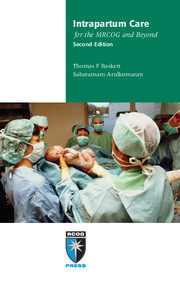Book contents
- Frontmatter
- Contents
- Preface
- Abbreviations
- 1 Improving intrapartum care
- 2 First stage of labour
- 3 Second stage of labour
- 4 Fetal surveillance in labour
- 5 Third stage of labour
- 6 Lower genital tract trauma
- 7 Induction of labour
- 8 Preterm labour and prelabour rupture of membranes
- 9 Assisted vaginal delivery
- 10 Shoulder dystocia
- 11 Breech vaginal delivery
- 12 Twin and triplet delivery
- 13 Caesarean section
- 14 Vaginal birth after caesarean section
- 15 Uterine rupture
- 16 Emergency obstetric hysterectomy
- 17 Cord prolapse
- 18 Antepartum haemorrhage
- 19 Postpartum haemorrhage
- 20 Acute uterine inversion
- 21 Amniotic fluid embolism
- 22 Disseminated intravascular coagulation
- 23 Acute tocolysis
- 24 Severe pre-eclampsia and eclampsia
- 25 Neonatal resuscitation
- 26 Perinatal loss: management of late fetal death and stillbirth
- Index
4 - Fetal surveillance in labour
Published online by Cambridge University Press: 05 July 2014
- Frontmatter
- Contents
- Preface
- Abbreviations
- 1 Improving intrapartum care
- 2 First stage of labour
- 3 Second stage of labour
- 4 Fetal surveillance in labour
- 5 Third stage of labour
- 6 Lower genital tract trauma
- 7 Induction of labour
- 8 Preterm labour and prelabour rupture of membranes
- 9 Assisted vaginal delivery
- 10 Shoulder dystocia
- 11 Breech vaginal delivery
- 12 Twin and triplet delivery
- 13 Caesarean section
- 14 Vaginal birth after caesarean section
- 15 Uterine rupture
- 16 Emergency obstetric hysterectomy
- 17 Cord prolapse
- 18 Antepartum haemorrhage
- 19 Postpartum haemorrhage
- 20 Acute uterine inversion
- 21 Amniotic fluid embolism
- 22 Disseminated intravascular coagulation
- 23 Acute tocolysis
- 24 Severe pre-eclampsia and eclampsia
- 25 Neonatal resuscitation
- 26 Perinatal loss: management of late fetal death and stillbirth
- Index
Summary
In his 2007 annual report, the Chief Medical Officer of England expressed his concern about the static perinatal mortality rate in the UK over 7 years. He highlighted the issue of intrapartum deaths in a chapter titled ‘Intrapartum-Related Deaths: 500 Missed Opportunities’. These were cases where the fetus was alive on admission but died during labour. The incidence of intrapartum deaths has declined compared with 1995, when the fourth annual report of the Confidential Enquiry into Stillbirths and Deaths in Infancy reported intrapartum death in 1/1600 fetuses weighing more than 1500 g with no chromosomal or congenital malformation. However, the factors that contributed to these deaths have not changed: inability to interpret the cardiotocograph (CTG) trace, failure to incorporate the ‘clinical picture’, delay in taking action and poor teamwork.
In addition to avoidable intrapartum fetal deaths, the incidence of hypoxic ischaemic encephalopathy (HIE) owing to birth asphyxia has not changed and remains about 2/1000, with 1/1000 being HIE grade I and the remainder being grades II and III. Grades II and III have a high correlation with asphyxia-related deaths and neurological injuries. The mortality and morbidity related to intrapartum asphyxia affect the quality of life of parents and siblings and are an enormous drain on taxpayers, who indirectly contribute to the National Health Services Litigation Authority, which pays out billions of pounds in compensation for obstetric negligence in cases of intrapartum-related neurological injury.
- Type
- Chapter
- Information
- Intrapartum Care for the MRCOG and Beyond , pp. 29 - 50Publisher: Cambridge University PressPrint publication year: 2011



